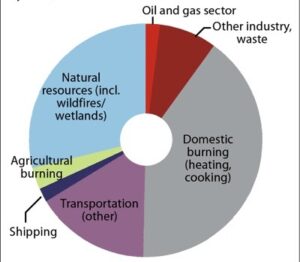Black carbon is a component of particulate matter. It has adverse impacts on human health, ecosystems as well as climate. It is important to know in detail its sources as well as impacts from mains point of view.
Dimensions
- What is Black Carbon and its effect on albedo
- Sources and origin of Black Carbon
- Ill effects of Black Carbon
- Snowmelt and its consequences
Content:
What is Black Carbon and its effect on albedo?
- It is a major constituent of soot.
- It is the most solar energy-absorbing component of particulate matter and can absorb one million times more energy than CO2.
- The amount of energy stored in the atmosphere is measured as watts per square meter of Earth’s surface.
- It is the second largest contributor to climate change after CO2.
- Black carbon, as a particle, remains in the atmosphere only for days to weeks before it returns to earth with rain or snow.
- Because black carbon absorbs solar energy, it warms the atmosphere.
- When it falls to earth with precipitation, it darkens the surface of snow and ice, reducing their albedo, warming the snow, and hastening melting.
- It affects the reflectivity, stability and duration of clouds and alters precipitation.
- Depending on how much soot is in the air and where black carbon sits in the atmosphere, it has different effects.
If it absorbs heat at the level where clouds are forming, they will evaporate.
If it lies above lower stratocumulus clouds that block the sun, it stabilizes them and thus has a cooling effect.
- It interacts with other components such as sulfates and nitrates that reflect sunlight and cool the atmosphere.
- Snow covered regions are the most vulnerable to the warming effects of black carbon.
- As glaciers melt and retreat, the ice melt that during the dry season feeds the rivers that supply irrigation systems will dwindle.
- As arctic ice continues to melt, there will be more shipping in the region, making it more likely that black carbon emissions from ships burning heavy fuel will increase in the future.
Sources and origin of Black Carbon:
- BC is produced both naturally and by human activities as a result of the incomplete combustion of fossil fuels, biofuels, and biomass.
- Primary sources include emissions from diesel engines, cook stoves, wood burning and forest fires.
- BC is also released in field burning of agricultural wastes, wildfires, residential heating and industry.
- Shipping industry also contributes to global BC.

- Developing countries in Asia, Africa and Latin America emit more than 75 percent of global black carbon emissions, mainly from cookstoves and the burning of solid fuels like coal and wood.
- Due to the location of these sources, the spatial variation of BC in ambient air is greater than that of PM2.5.
Ill effects of Black Carbon:
- Black carbon may operate as a universal carrier of a wide variety of chemicals of varying toxicity to the human body.
- Exposure to black carbon is linked to health impacts such as cardiopulmonary morbidity and mortality.
- Affects visibility and decreases agricultural productivity.
- As it is released during heating, its absorption affects the health of women and girls.
Snowmelt and its consequences:
- According to a study published in the journal Nature Climate Change, black carbon has a large effect on snow darkening and resultant melting of snow.
- As black carbon emission is a surface phenomenon it influences melting of snow from surface to about 3 km elevation.
- Based on remote sensing data of spatial distribution of dust aerosol concentration over the Indian subcontinent, it is shown that the relative impacts of dust and black carbon vary with surface elevation of snowpack.
- Dust particles are transported from as far as Saudi Arabia get deposited in the Western Himalayan Region – Hindu Kush, Karakoram and western Himalaya ranges.
- This is the first time the role of long-distance transported dust in elevational heterogeneity of snow melting in the Himalayas has been made.
- Black carbon has a larger snow albedo darkening effect than dust due to a larger mass absorption efficiency.
- Black carbon mainly contributes to snow melt at lower elevation while dust is the major contributor for snowmelt at higher elevation.
- Due to global warming, snow cover at lower elevations in the Himalayas will occur less frequently or totally disappear compared with snow cover at higher elevations.
- Dust deposition during the pre-monsoon period causes early snowmelt water in the Himalayan rivers and a reduction of snowmelt water during peak summer months.
- What is Black Carbon? How does it affect the albedo of the earth?
Approach to the answer:
- Write about black Carbon and its sources
- Explain how it affects the albedo
- Mention the other ill effects
- Conclusion
















